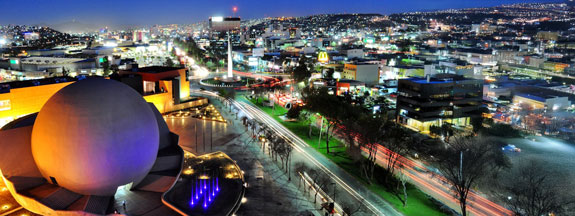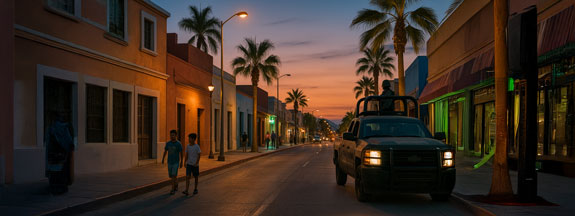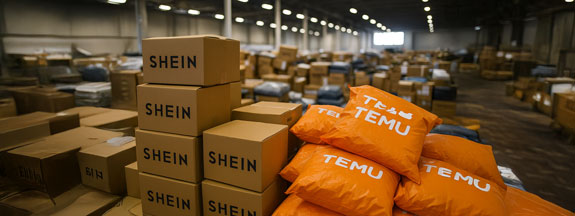Someone on an expat group on Facebook was horrified that the city of Rosarito, Baja California, just brought in 400 federal troops to keep the peace. What he didn’t know—because he apparently doesn’t watch the news and can’t be bothered to know what’s going on around him—is that the federal police came not because there was a surge in violence, but because Rosarito just fired half of their municipal police officers for failing their police exams.
This is a temporary solution. New officers are already being trained at the police academy. But instead of asking questions or trying to understand the situation, the expat did what many Americans, especially MAGA Americans who can’t be bothered to learn Spanish, do best: he panicked.
Without evidence, without context, he jumped straight to the one-size-fits-all U.S. solution: more guns.
“Mexico needs to allow open carry. It’s so dangerous I can’t even go to Oxxo!”
(Except, of course, it isn’t. And yes, you can go to Oxxo whenever you want.)
This mindset—that more civilian guns automatically mean more safety—isn’t just wrong. It’s dangerous. And if Mexico wants to learn from its neighbor to the north, it should start by learning what not to do.
The False Promise: “More Guns = Less Crime”
| State | Gun Law Grade (Giffords) [1](#sources) | Firearm Homicide Rate (per 100k) |
|---|---|---|
| California | A | 3.9 |
| Massachusetts | A- | 1.5 |
| Missouri | F | 11.1 |
| Louisiana | F | 14.6 |
| Arizona | F | 8.8 |
When Americans talk about “more guns equals less crime,” they’re usually repeating a slogan, not citing evidence.
The actual data tells a very different story.
The RAND Corporation2, one of the most respected independent research institutions in the United States, conducted a sweeping review of over two decades of gun policy studies. Their conclusion?
Policies that make it easier to carry guns in public—like open carry and permitless concealed carry—are consistently associated with higher rates of violent crime and homicide. Not lower.
Specifically:
- Permissive concealed carry laws correlate with an increase in violent crime, including murders.
- Stand-Your-Ground laws, which expand the ability to use deadly force in public confrontations, also correlate with a rise in homicides.
RAND found no solid evidence2 that broader civilian gun carrying deters crime. In fact, the opposite often happens:
- More guns escalate conflicts that might otherwise end in a fistfight or words.
- More guns increase the chance of accidental shootings.
- More guns make it easier for arguments, road rage incidents, and even petty disputes to turn deadly.
Meanwhile, states with stricter gun laws—strong background checks, safe storage laws, waiting periods—tend to have lower rates of gun deaths across the board, including homicides.
In short: more guns don’t scare criminals away. They just make sure more people die when things go wrong.
And that’s in the U.S.—a country with far more police resources, surveillance technology, and judicial infrastructure than Mexico has right now.
Why would anyone think it would work better here?
The American Experience: When Looser Gun Laws Backfire
If more civilian guns really made society safer, the United States should be the safest country in the world. It isn’t.
In fact, some of the U.S. states with the weakest gun laws—Missouri, Louisiana, Mississippi, Arizona1—also suffer from the highest rates of gun deaths.
Let’s take Missouri as a real-world case study:
- In 2007, Missouri repealed its permit-to-purchase requirement for handguns.
- What happened? Homicide rates immediately spiked.
- A peer-reviewed study in the Journal of Urban Health found that Missouri’s firearm homicide rate jumped by 25% after the repeal. No other neighboring state saw a similar rise.
It’s not just Missouri.
- Louisiana, which has some of the loosest gun laws in the country, regularly competes for the highest gun homicide rate per capita.
- Arizona gutted its concealed carry regulations—and saw no miraculous drop in crime.
Even Florida, often praised by gun advocates for “responsible gun ownership,” has struggled with rising firearm death rates despite years of relaxing gun laws.
The pattern repeats over and over:
- Weaker laws.
- More guns.
- More violence.
And then came the COVID-19 pandemic, where fear and instability supercharged gun purchases. The U.S. saw the biggest single-year spike in gun homicides4 in modern history—despite the country having more legally owned guns than people5.
If “good guys with guns” were going to save the day, 2020 and 2021 would have looked very different.
Instead, it looked like chaos. Just like it would if Mexico tried to follow the same broken blueprint.
Mexico’s Unique Danger: Organized Crime, Not Ordinary Criminals
The kind of violence Mexico faces isn’t about petty theft. It’s not about random criminals hoping to mug someone outside an Oxxo.
It’s about cartels—organized crime groups with military-grade firepower, armored vehicles, encrypted communications, and armies of professional killers.
These groups aren’t scared of a few more civilians carrying pistols. They’re armed with AK-47s, Barrett .50 caliber sniper rifles, and RPGs9—many of them smuggled in illegally from the United States3.
In this environment, expanding civilian open carry won’t bring peace.
It will create more opportunities for firearms to leak into the black market, more chances for violent confrontations, and more excuses for organized crime to justify deadly force in public spaces.
Think about it:
- A tourist carrying a legal pistol is not going to deter a convoy of cartel gunmen.
- A store clerk with a concealed carry permit is not going to stop a coordinated extortion operation.
- A neighborhood watch group armed with handguns is not going to survive a cartel ambush.
This isn’t a Hollywood movie. It’s asymmetrical warfare.
And flooding the streets with even more weapons—even legally owned ones—only adds fuel to a fire Mexico is already struggling to contain.
The real battle isn’t over arming civilians.
It’s over shutting down the massive illegal weapons pipeline that supplies the cartels—and building trustworthy, effective public security forces that can enforce the law without corruption or fear.
The Real Problem: U.S. Guns, Not Mexican Laws
Mexico already has some of the strictest gun control laws in the world10.
- One legal gun store.
- Heavy background checks.
- Severe restrictions on caliber and type.
- Permits almost impossible to get.
And yet, gun violence still rages. Why?
Because the problem isn’t Mexico’s laws—it’s the flood of illegal guns coming from the United States.
According to the U.S. Government Accountability Office (GAO), about 70% of guns recovered from crime scenes in Mexico3 can be traced back to U.S. sales.
Most of them come from states with weak gun regulations, where straw purchases and unregulated private sales are easy to exploit.
Every year, an estimated 200,000 guns are trafficked across the border3 into Mexico.
This black market arms trade supplies the cartels with weapons that outclass anything available to average civilians—or even most local police forces.
So when an American expat claims that “Mexico needs open carry to defend itself,” they’re ignoring the real source of the problem:
It’s not that Mexican citizens are too disarmed. It’s that Mexican criminals are too well-armed—thanks to the United States.
Until that flood of illegal U.S. guns is controlled, no amount of civilian carry permits will tip the balance.
More legal guns among the general population won’t fix a problem that’s fundamentally driven by international arms trafficking and organized crime power structures.
What Mexico Needs Instead
Mexico doesn’t need to copy the U.S.’s failed experiments with more guns. It needs solutions that actually address the roots of violence, not just react to the symptoms.
Here’s what would actually make a difference:
-
Stronger Border Arms Control:
Mexico needs more aggressive tracking, interception, and cooperation with the U.S. to cut off the illegal flow of weapons at the source.No gun, no murder weapon. It’s that simple.
-
Professionalized, Clean Law Enforcement:
Rosarito firing half its police force for failing standards is a good thing—not a crisis.Building police forces that are better trained, vetted, and paid enough to resist corruption is key to long-term safety.
-
Community-Based Violence Prevention:
Not vigilante groups with handguns, but trusted mediators, intervention programs, and public investment that makes crime a worse career option than legitimate work. -
Intelligence-Led Operations Against Organized Crime:
Going after the money, weapons supply lines, and leadership networks that keep cartels running, instead of just firefights and body counts. -
International Pressure on U.S. Gun Exports:
Mexico has already filed lawsuits against U.S. gun manufacturers for their role in arms trafficking. It should double down and make arms control a diplomatic priority.
The answer to organized violence isn’t turning every street corner into a potential shootout between scared civilians and cartel gunmen.
It’s cutting the oxygen off at the source:
- Stop the flow of illegal guns.
- Strengthen the institutions that protect communities.
- Attack the economic and operational power of organized crime.
That’s the hard work. And it’s the only work that will actually make Mexico safer.
Don’t Copy a Broken Model
Mexico doesn’t need more guns. It needs more solutions.
The U.S. is living proof that saturating a country with firearms doesn’t guarantee safety—it guarantees that when things go wrong, they turn deadly.
Missouri tried it. Louisiana tried it. Arizona tried it.
They didn’t become safer. They became bloodier.
Mexico has a chance to learn from those mistakes instead of repeating them.
It has a chance to focus on breaking the grip of organized crime, shutting down the black market for weapons, and rebuilding trust in public institutions.
Arming civilians to fight cartels isn’t just unrealistic—it’s a distraction from the real battle.
The fight isn’t for more guns on the streets.
It’s for fewer funerals.
If Mexico follows the U.S. down the road of “more guns, more freedom,” it won’t find freedom waiting at the end.
Only more graves.




Leave a comment